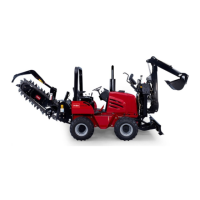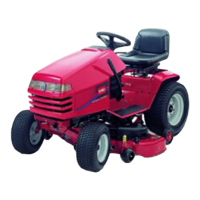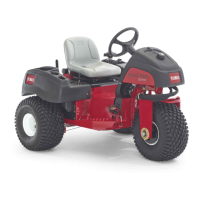Operation
Note:Determinetheleftandrightsidesofthemachine
fromthenormaloperatingposition.
PreparingforWork
Beforeoperatingthemachineonthejobsite,reviewthe
followingitems:
•Gatherallrelevantinformationavailableaboutthejob
sitebeforeyoubeginworking.
•Reviewallblueprintsandotherplans,andidentifyall
existingorproposedstructures,characteristicsofthe
landscape,andotherproposedjobsintheareascheduled
atthesametimeasyourjob.
Notethefollowingitemsatthejobsite:
–Changesinelevationintheproposedworkarea
–Theconditionandtypeofsoilintheproposedwork
area
–Locationsofstructures,water,railroadtracks,and
otherobstructionsthatyouwillneedtoworknear
oraround
–Utilitymarkers,meters,andpoles
–Iftheworksiteisnearoronaroadwaywithtrafc,
callthelocalauthoritiesregardingpropersafety
proceduresandregulations.
–Accesstothesite
•CallyourlocalOne-Callservice(811intheUS)orthe
One-Callreferralnumber(888-258-0808intheUSand
Canada)andasktheparticipatingutilitycompaniesto
locateandmarktheirundergroundutilitylines.Alsocall
utilityprovidersthatarenotpartoftheOne-Callsystem.
AddingFueltotheEngine
Useultra-lowsulfurdiesel(ULSD)fuelintheengine.Using
otherfuelscancausealossofenginepowerandhighfuel
consumption.
Important:Donotusekeroseneorgasolineinsteadof
dieselfuel;otherwise,youwilldamagetheengine.
UseonlydieselfuelforthemachinethatmeetsSpecication
D975oftheAmericanSocietyforTestingandMaterials
International.Seeyourdieselfueldistributor.
Useonlyclean,freshdieselfuelorbiodieselfuelswithlow
(<500ppm)orultralow(<15ppm)sulfurcontent.The
minimumcetaneratingshouldbe40.Purchaseonlyenough
fuelthatyouexpecttousewithin30daystoensurethatit
staysfresh.
Fueltankcapacity:75.7L(20USgal)
Usesummer-gradedieselfuel(No.2-D)attemperatures
above20°F(-7°C)andwinter-gradedieselfuel(No.1-Dor
No.1-D/2-Dblend)below20°F(-7°C).Usingwinter-grade
fuelatlowertemperaturesprovidesalowerashpointand
coldowcharacteristics,whichaidinstartingtheengineand
helppreventcloggingthefuellter.
Usingsummer-gradefuelabove20°F(-7°C)contributes
towardalongerfuelpumplifeandincreasedpowercompared
tousingwinter-gradefuel.
WARNING
Fuelisharmfulorfatalifswallowed.Long-term
exposuretofuelvaporscancauseseriousinjury
andillness.
•Avoidprolongedbreathingofvapors.
•Keepyourfaceawayfromnozzleandfueltank
orconditioneropening.
•Keepfuelawayfromyoureyesandskin.
DANGER
Incertainconditions,fuelisextremelyammable
andhighlyexplosive.Areorexplosionfromfuel
canburnyouandothersandcandamageproperty.
•Fillthefueltankoutdoorsinanopenareawhen
theengineiscold.Wipeupanyfuelthatspills.
•Neverllthefueltankinsideanenclosedtrailer.
•Neversmokewhenhandlingfuel,andstayaway
fromanopenameorwherefuelfumesmaybe
ignitedbyaspark.
•Storefuelinanapprovedcontainer,andkeep
itoutofthereachofchildren.Neverbuymore
thana30-daysupplyoffuel.
•Donotoperatewithoutentireexhaustsystemin
placeandinproperworkingcondition.
Incertainconditions,fuelingcanreleasestaticelectricityand
causeaspark,whichcanignitethefuelvapors.Areor
explosionfromfuelcanburnyouandothersandcandamage
property.
•Alwaysplacefuelcontainersontheground,awayfrom
yourvehiclebeforelling.
•Donotllfuelcontainersinsideavehicleoronatruck
ortrailerbed,becauseinteriorcarpetsorplastictruck
bedlinersmayinsulatethecontainerandslowtheloss
ofanystaticcharge.
•Whenpractical,removetheequipmentfromthetruck
ortrailer,andrefueltheequipmentwithitswheelson
theground.
•Ifrefuellingtheequipmentwithitswheelsontheground
isnotpossible,thenrefuelsuchequipmentonatruckor
trailerfromaportablecontainerratherthanfromafuel
dispensernozzle.
•Ifyoumustuseafueldispensernozzle,keepthenozzlein
contactwiththerimofthefueltankorcontaineropening
atalltimesuntilfuelingiscomplete.
22
